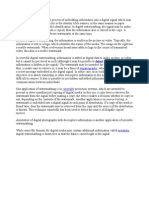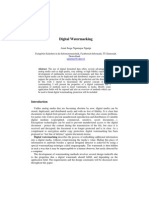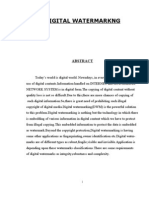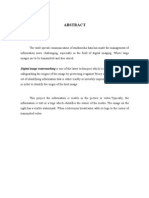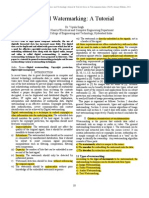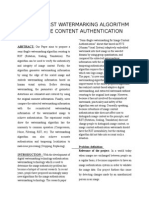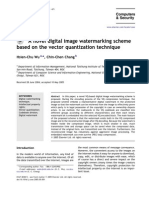Watermarking Is The Process To Hide Some Data Which Is Called Watermark or Label Into The Original Data. Similar
Watermarking Is The Process To Hide Some Data Which Is Called Watermark or Label Into The Original Data. Similar
Uploaded by
Joy BagdiOriginal Description:
Original Title
Copyright
Available Formats
Share this document
Did you find this document useful?
Is this content inappropriate?
Report this DocumentCopyright:
Available Formats
Watermarking Is The Process To Hide Some Data Which Is Called Watermark or Label Into The Original Data. Similar
Watermarking Is The Process To Hide Some Data Which Is Called Watermark or Label Into The Original Data. Similar
Uploaded by
Joy BagdiCopyright:
Available Formats
Image Watermarking implies the embedding of a particular image or a watermark inside a useful piece of
information that needs to be protected from copyright
Digital video watermarking is a technique which is utilized to ensure the verification and approval rights for the video files. In this
process, a binary image is embedded into the video frames as a watermark so as to protect the ownership of original video file. [2]
Watermarking is the process to hide some data which is called watermark or label into the original data. Similar
video watermarking embeds data in the video for the purpose of identification, annotation and copyright.
In watermark embedding, a watermark signal (Text, image or audio etc) is constructed and then embedded into an original signal (Video)
to produce the watermarked signal. Once embedding is done, the watermarked video can be subjected to various attacks. During watermark
detection, the watermark detector is given a test signal that may be watermarked, attacked or not. The watermark detector reports whether the
watermark is present or not on examining the signal at its input [21]. Watermarking technique is to hide secret information into the digital
signals so as to discourage unauthorized copying or attest the origin of the media. The watermark is a digital code embedded in the image
data and is invisible [5]. A digital watermark is permanently embedded in the data, that is, it remains present within the original data after any
distortion process. A watermark could be used to provide proof of authorship of a signal.
Digital watermarking (or, hereafter, watermarking) is a technique for protecting the intellectual property of a digital
object; the idea is simple: a unique marker, which is called watermark, is embedded into a digital object which may be
used to verify its authenticity or the identity of its owners [6, 7]. More precisely, watermarking can be described as the
problem of embedding a watermark w into an object O and, thus, producing a new object Iw, such that w can be reliably
located and extracted from Ow even after Ow has been subjected to transformations [7]; for example, compression, scaling
or rotation in case where the object is an image. In the image watermarking process the digital information, i.e., the
watermark, is hidden in image data. The watermark is embedded into image’s data through the introduction of errors not
detectable by human perception [8]; note that, if the image is copied or transferred through the internet then the
watermark is also carried with the copy into the image’s new location.
Watermarking is a process that embeds data into a multimedia object to protect the owner‟s ownership to the objects. A watermark
is a pattern of bits embedded into a digital image audio or video files that give the file copyright information. Unlike printed
watermarks, which are intended to be somewhat visible (like the very light compass stamp watermarking). Digital watermarks are
designed to be completely invisible, or in the case of audio clips, inaudible [2].
The purpose of watermarking is to add some extra information (a message) to the image. The
messages that are normally encoded in the water-marks are closely related to the author/copyright
holder of the image, such as their name and/or other copyright information.
Digital watermarking is an information hiding technique, the early definition of which is “the practice of imperceptibly altering a
Work to embed a message about that Work” (Cox et al. 2002a). Additional data is embedded in digital media in a sense that it is
perceptually undetectable, tightly coupled to the cover media and furthermore the hidden data can be detected or recovered after a set
of manipulations
[wiki]A digital watermark is a kind of marker covertly embedded in a noise-tolerant signal such as an audio, video or
image data. It is typically used to identify ownership of the copyright of such signal. "Watermarking" is the process of
hiding digital information in a carrier signal; the hidden information should,[1] but does not need to, contain a relation to
the carrier signal.
You might also like
- Naked Into The WildernessDocument3 pagesNaked Into The WildernessChinaGateCoverupNo ratings yet
- XMP1 System Description R5.5 PDFDocument374 pagesXMP1 System Description R5.5 PDFIan CutinNo ratings yet
- WatermarkingDocument1 pageWatermarkingtarasimadhuNo ratings yet
- Steganography Watermarking LectureslidesDocument50 pagesSteganography Watermarking Lectureslidesyunav25No ratings yet
- Survey On Digital Video Watermarking Techniques, Attacks and ApplicationsDocument6 pagesSurvey On Digital Video Watermarking Techniques, Attacks and ApplicationsEditor IJTSRDNo ratings yet
- A Survey Work On Digital WatermarkingDocument4 pagesA Survey Work On Digital WatermarkingNguyễn Văn Hùng DũngNo ratings yet
- Ijcet: International Journal of Computer Engineering & Technology (Ijcet)Document8 pagesIjcet: International Journal of Computer Engineering & Technology (Ijcet)IAEME PublicationNo ratings yet
- My File FinalDocument51 pagesMy File FinalApne DipuNo ratings yet
- A Review of Digital Watermarking: International Journal of Application or Innovation in Engineering & Management (IJAIEM)Document3 pagesA Review of Digital Watermarking: International Journal of Application or Innovation in Engineering & Management (IJAIEM)International Journal of Application or Innovation in Engineering & ManagementNo ratings yet
- Watermarking 2Document11 pagesWatermarking 2rambabucvNo ratings yet
- Digital WatermarkingDocument6 pagesDigital WatermarkingMa SeenivasanNo ratings yet
- Text Watermarking Using Combined Image and Text For Authentication and ProtectionDocument6 pagesText Watermarking Using Combined Image and Text For Authentication and ProtectionSaurabh BhiseNo ratings yet
- Digital WatermarkingDocument12 pagesDigital Watermarkingami2009No ratings yet
- ReportDocument30 pagesReportHetali TopiwalaNo ratings yet
- 1.1 Overview of The Project: Data Hiding Can Be Defined As The Process by Which A Message Signals or Image IsDocument49 pages1.1 Overview of The Project: Data Hiding Can Be Defined As The Process by Which A Message Signals or Image IssamNo ratings yet
- Digital Watermarking: A TutorialDocument12 pagesDigital Watermarking: A TutorialCyberJournals MultidisciplinaryNo ratings yet
- ABSTRACTDocument1 pageABSTRACTSenthil Kumar KrishnanNo ratings yet
- Digital WatermarkingDocument3 pagesDigital WatermarkingAmrita Saloni SinghNo ratings yet
- Digital Audio Watermarking Using Digital Wavelet Transform: AbstractDocument17 pagesDigital Audio Watermarking Using Digital Wavelet Transform: AbstractVrushali KhatpeNo ratings yet
- 1 s2.0 S2666285X21000637 MainDocument6 pages1 s2.0 S2666285X21000637 MainDavis PunjilaNo ratings yet
- DigitalmarkDocument1 pageDigitalmarkDinesh KumarNo ratings yet
- Anjaneyulu Base PaperDocument28 pagesAnjaneyulu Base PaperRevanthkumarNo ratings yet
- Digital Water MarkingDocument7 pagesDigital Water Marking4ndr01d0n3No ratings yet
- Image Watermarking Techniques in Spatial Domain: A ReviewDocument7 pagesImage Watermarking Techniques in Spatial Domain: A ReviewCannyNo ratings yet
- Digital Watermarking: By, Prathyusha S 12012D0519Document24 pagesDigital Watermarking: By, Prathyusha S 12012D0519Srivenu ChinnaNo ratings yet
- A Seminar Report On Digital Watermarking: by Prashant Kawale 2008H103034Document17 pagesA Seminar Report On Digital Watermarking: by Prashant Kawale 2008H103034rajesh_kumar282No ratings yet
- Digital Water MarkingDocument6 pagesDigital Water Markingsiri831No ratings yet
- Major Project SynopsisDocument16 pagesMajor Project SynopsissaurabhNo ratings yet
- Information Security by Biometric WaterkingDocument3 pagesInformation Security by Biometric WaterkingInternational Journal of Research in Engineering and TechnologyNo ratings yet
- Digital Watermarking: A TutorialDocument12 pagesDigital Watermarking: A TutorialJiawei LinNo ratings yet
- A Crypto-Watermarking MethodDocument11 pagesA Crypto-Watermarking Methodmycatalysts100% (1)
- Paper Videpo TraDocument5 pagesPaper Videpo Trapalak patelNo ratings yet
- Crypto Watermarking Method For Medical Images 5721 NDgZaOtDocument13 pagesCrypto Watermarking Method For Medical Images 5721 NDgZaOtPadma 18-511No ratings yet
- Resisting RST Watermarking Algorithm For Image Content AuthenticationDocument14 pagesResisting RST Watermarking Algorithm For Image Content AuthenticationAditya UparkarNo ratings yet
- Robust Image Watermarking Theories and Techniques: A Review: Vol.12, February2014Document17 pagesRobust Image Watermarking Theories and Techniques: A Review: Vol.12, February2014evergreenman55No ratings yet
- A Review Paper On Digital WatermarkingDocument7 pagesA Review Paper On Digital WatermarkingInternational Journal of Application or Innovation in Engineering & ManagementNo ratings yet
- Watermark Introduction (ALL)Document106 pagesWatermark Introduction (ALL)Raunak RungtaNo ratings yet
- Dig WatermarkDocument46 pagesDig WatermarkAparna GoliNo ratings yet
- Recent Water1Document8 pagesRecent Water1Jeet SharmaNo ratings yet
- SdarticleDocument12 pagesSdarticleasifmechengrNo ratings yet
- Digital Watermarking: o o o oDocument8 pagesDigital Watermarking: o o o oselvadpm5No ratings yet
- An Adaptive Watermarking Technique For The Copyright of Digital Images and Digital Image ProtectionDocument18 pagesAn Adaptive Watermarking Technique For The Copyright of Digital Images and Digital Image ProtectionIJMAJournalNo ratings yet
- Digital Watermarking: I. Watermarking Life-Cycle PhasesDocument2 pagesDigital Watermarking: I. Watermarking Life-Cycle PhasesJatin AroraNo ratings yet
- Chapter No 3 Importance of Digital WatermarkingDocument5 pagesChapter No 3 Importance of Digital WatermarkingAdila ZahidNo ratings yet
- Digital WatermarkingDocument19 pagesDigital WatermarkingsruthiNo ratings yet
- Introduction of Image Authentication Techniques & AvsDocument35 pagesIntroduction of Image Authentication Techniques & AvsNitin MathurNo ratings yet
- A Review On Digital Image Watermarking Using 3-Level Discrete Wavelet TransformDocument7 pagesA Review On Digital Image Watermarking Using 3-Level Discrete Wavelet TransformShahid RanaNo ratings yet
- Digital Watermarking by SanuDocument14 pagesDigital Watermarking by SanuSwati1101No ratings yet
- Multimedia Security Digital Video Watermarking: Bhasker NDocument16 pagesMultimedia Security Digital Video Watermarking: Bhasker Nbhasker_visionNo ratings yet
- Fragile Invisible Watermark Technique: Y.Parvathi B.tech, C.S.E (2 Yr.) RGMC of Engineering & Technology, Nandyal E-MailDocument10 pagesFragile Invisible Watermark Technique: Y.Parvathi B.tech, C.S.E (2 Yr.) RGMC of Engineering & Technology, Nandyal E-MailSai Kiran VemulaNo ratings yet
- Synopsis of Digital WatermarkingDocument15 pagesSynopsis of Digital WatermarkingAryan MehraNo ratings yet
- Image Authentication: Keywords: Watermark, Transform Domain, DCT, FFT, Picture CroppingDocument9 pagesImage Authentication: Keywords: Watermark, Transform Domain, DCT, FFT, Picture Croppingapi-26172869No ratings yet
- V3i9201429 PDFDocument6 pagesV3i9201429 PDFAshish DahiyaNo ratings yet
- Multimedia Document Authentication Using On-Line Signatures As WatermarksDocument10 pagesMultimedia Document Authentication Using On-Line Signatures As WatermarksMutahira TahirNo ratings yet
- A Synopsis On "Performance Comparative Analysis of Multiple Techniques Used For Encryption & Digital Watermarking"Document21 pagesA Synopsis On "Performance Comparative Analysis of Multiple Techniques Used For Encryption & Digital Watermarking"ravikiran1955No ratings yet
- Digital WatermarkingDocument18 pagesDigital WatermarkingZainab Aafia100% (2)
- Digital Watermarking in Images Using DWT in MatlabDocument20 pagesDigital Watermarking in Images Using DWT in MatlabDivyanshu NandwaniNo ratings yet
- TechDocument2 pagesTechJayakar KurimillaNo ratings yet
- Digital WatermarkingDocument32 pagesDigital WatermarkingDavis PunjilaNo ratings yet
- 8 Vol2Document13 pages8 Vol2Research Cell: An International Journal of Engineering SciencesNo ratings yet
- A Survey: Digital Image Watermarking TechniquesDocument14 pagesA Survey: Digital Image Watermarking Techniquesvidhyasree123No ratings yet
- Digital Video Fingerprinting: Enhancing Security and Identification in Visual DataFrom EverandDigital Video Fingerprinting: Enhancing Security and Identification in Visual DataNo ratings yet
- SyllabusDocument3 pagesSyllabusJoy BagdiNo ratings yet
- FertDocument38 pagesFertJoy BagdiNo ratings yet
- Case Studies: Needham - Schroeder, Kerberos, TLS, 802.11 WifiDocument2 pagesCase Studies: Needham - Schroeder, Kerberos, TLS, 802.11 WifiJoy BagdiNo ratings yet
- Chap 9. Distributed Systems Architectures: - Architectural Design For Software That Executes On More Than One ProcessorDocument43 pagesChap 9. Distributed Systems Architectures: - Architectural Design For Software That Executes On More Than One ProcessorJoy BagdiNo ratings yet
- Distributed Systems Characterization and Design: 1DT057 D I SDocument35 pagesDistributed Systems Characterization and Design: 1DT057 D I SJoy BagdiNo ratings yet
- Concurrency in Shared Memory Systems: Synchronization and Mutual ExclusionDocument37 pagesConcurrency in Shared Memory Systems: Synchronization and Mutual ExclusionJoy BagdiNo ratings yet
- Map Reduce: Simplified Processing On Large ClustersDocument29 pagesMap Reduce: Simplified Processing On Large ClustersJoy BagdiNo ratings yet
- Wave and Traversal AlgorithmsDocument10 pagesWave and Traversal AlgorithmsJoy BagdiNo ratings yet
- BS Vii PDFDocument3 pagesBS Vii PDFJoy BagdiNo ratings yet
- Cuckoo Search Algorithm: Dr. Ahmed Fouad AliDocument20 pagesCuckoo Search Algorithm: Dr. Ahmed Fouad AliJoy BagdiNo ratings yet
- Course Title: Group Dynamics and Team Building Credit Units: 1 Course Level: UG Course Code: BS301 Course ObjectivesDocument3 pagesCourse Title: Group Dynamics and Team Building Credit Units: 1 Course Level: UG Course Code: BS301 Course ObjectivesJoy BagdiNo ratings yet
- AlgorithmDocument18 pagesAlgorithmJoy BagdiNo ratings yet
- I Fundamentals 1Document593 pagesI Fundamentals 1Joy BagdiNo ratings yet
- Iit Wise Gate Analysis Computer ScienceDocument4 pagesIit Wise Gate Analysis Computer ScienceJoy BagdiNo ratings yet
- Peta PenelitianDocument12 pagesPeta PenelitianBapaknya AliNo ratings yet
- Material Safety Data Sheet: CPS Pro Set Vacuum Pump OilDocument3 pagesMaterial Safety Data Sheet: CPS Pro Set Vacuum Pump OilPaul Christian Rojas FloresNo ratings yet
- Socket Programming in JavaDocument4 pagesSocket Programming in JavaKumar SaketNo ratings yet
- VAE Based AdhesiveDocument8 pagesVAE Based Adhesivehabiba jamilNo ratings yet
- Lop 7 de HSG Tieng AnhDocument22 pagesLop 7 de HSG Tieng AnhThảo NguyênNo ratings yet
- ABIM Laboratory Test Reference Ranges January 2019Document12 pagesABIM Laboratory Test Reference Ranges January 2019PUSKESMASNo ratings yet
- IELTS Speaking Part 1 - IBESTDocument32 pagesIELTS Speaking Part 1 - IBESTSUSAN SANTIKANo ratings yet
- Getting Paid Note Taking Guide 2.3.9.L1 PDFDocument3 pagesGetting Paid Note Taking Guide 2.3.9.L1 PDFJulianna ChmielNo ratings yet
- 7th Sem AssignmentDocument20 pages7th Sem AssignmentPrashant MittalNo ratings yet
- Oracle Applications - GL - Oracle R12 General Ledger ER Diagram (Table Joinings)Document3 pagesOracle Applications - GL - Oracle R12 General Ledger ER Diagram (Table Joinings)Kassim KassimNo ratings yet
- Synopsis PresentationDocument13 pagesSynopsis PresentationSivaNandan AjithNo ratings yet
- PsuDocument2 pagesPsuManas KapoorNo ratings yet
- Principles of Home EconomicsDocument2 pagesPrinciples of Home EconomicsCamille DelfinNo ratings yet
- Best Thesis Topics For Electrical EngineeringDocument5 pagesBest Thesis Topics For Electrical Engineeringafjryiome100% (2)
- Chapter 1A: Introducing Computer SystemsDocument35 pagesChapter 1A: Introducing Computer SystemsEHSAN ULLAHNo ratings yet
- 17 Flight Attendants and Stewards Association of The Philippines vs. Philippine Airlines, Inc.Document50 pages17 Flight Attendants and Stewards Association of The Philippines vs. Philippine Airlines, Inc.joyeduardoNo ratings yet
- Cot CLP On Bias and PrejudiceDocument5 pagesCot CLP On Bias and Prejudicechepie creenciaNo ratings yet
- Michael Farrell - The Effective Teachers' Guide Autism and Other Communication Difficulties - Practical Strategies (New Directions in Special Educational Needs) (2005)Document113 pagesMichael Farrell - The Effective Teachers' Guide Autism and Other Communication Difficulties - Practical Strategies (New Directions in Special Educational Needs) (2005)chopitoNo ratings yet
- PenholdersDocument8 pagesPenholdersBilly BlattNo ratings yet
- Precht L 1997Document3 pagesPrecht L 1997Javiera Rodriguez QuezadaNo ratings yet
- Software Engglec2Document49 pagesSoftware Engglec2Khan ZadaNo ratings yet
- Fresh Wind Fresh FireDocument11 pagesFresh Wind Fresh FireLexie TanNo ratings yet
- And OECD Guidelines: Practical Overview of The LinkagesDocument76 pagesAnd OECD Guidelines: Practical Overview of The LinkagesH Kurniawan KNo ratings yet
- PRM - Ma5 BookletDocument25 pagesPRM - Ma5 BookletVan LabasanoNo ratings yet
- Acknowledgement To SummaryDocument11 pagesAcknowledgement To SummaryMadhuSudan PallapuNo ratings yet
- Conexión A Tierra Del Neutro de Los: Generadores en Plantas PetroquímicasDocument6 pagesConexión A Tierra Del Neutro de Los: Generadores en Plantas PetroquímicasSergio RodriguezNo ratings yet
- Vertical Wall Earthbag HomesDocument4 pagesVertical Wall Earthbag Homesdanut_docNo ratings yet
- Ho Ching Ella - Public Resume 2Document1 pageHo Ching Ella - Public Resume 2api-510664967No ratings yet


